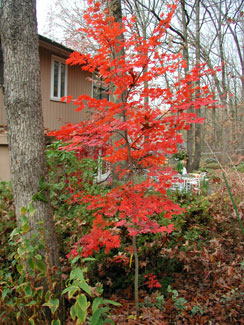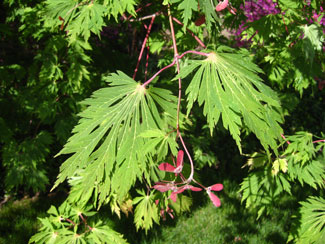Resource Library
Plant of the Week: Maple, Full Moon
The University of Arkansas System Division of Agriculture does not promote, support or recommend plants featured in "Plant of the Week." Please consult your local Extension office for plants suitable for your region.
Plant of the Week
Full Moon Maple
Latin: Acer japonicum

Japanese maples are lovely small trees well worth space in the garden and the little amount of effort needed to grow them. Though treated as a monolithic group, Japanese maples (Acer palmatum in several botanical variations) comprise only one species of plants that look like what we consider Japanese maples. One of the other important species is Acer japonicum, a group sometimes called the Full Moon maple because of its more or less rounded leaf.
Acer japonicum is a small deciduous tree growing to 25 feet tall and wide. The cut-leafed types tend to be smaller, seldom exceeding 15 feet in height and resemble a shrub with lots of upright, basal branching. Full moon maple closely resembles Japanese maple except that the former species has pubescence on the underside of the leaf while the latter is without hairs.
The full moon maple is called such because its leaf gives the appearance of roundness with 7 to 12 lobes. Purple-leafed selections are not found in this genus. In the wild form the lobes are short but some of the selections have deep lobes that cut the leaf almost all the way back to the petiole.
Cultivars such as ‘Aconitifolium’, ‘Green Cascade’ and ‘Vitifolium’ are selections made for their large, deeply cut leaves and good fall color. Of the two species, full moon maple has the better fall colors in shades of orange, red and yellow, often displayed on the same plant. Color change is late, often not coming on until after mid-November.
The full moon maples were first described by Carl Peter Thunberg (1743-1828), a Swedish naturalist and student of Linnaeus who is best known for the two years he spent in Japan around 1775. The species is not as widely grown in Japanese or American gardens as Acer palmatum cultivars, but is worth chasing down for its superior fall color. Additionally, during the late-season freeze of 2007, my two full moon maples, probably because they were later to leaf out, did not have the extensive dieback of the dozen or so Acer palmatum clones.

Full moon maples can be used in the garden as small patio or specimen trees either in full sun or in light shade. They are adaptable to average garden soil conditions and seem to be no more or less drought tolerant than Japanese maples. They have a slow growth rate. Trees are cold hardy to zone 5 north and can be grown through zone 8 in the South.
By: Gerald Klingaman, retired
Retired Extension Horticulturist - Ornamentals
Extension News - May 3, 2013
The University of Arkansas System Division of Agriculture does not maintain lists of retail outlets where these plants can be purchased. Please check your local nursery or other retail outlets to ask about the availability of these plants for your growing area.